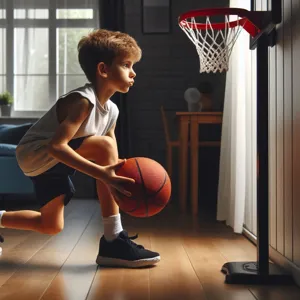As the sun sets on another busy day, there’s nothing quite like the satisfying sound of a basketball swishing through the net, echoing in the quiet of your driveway or backyard.
Whether you’re a seasoned player looking to sharpen your skills or a beginner eager to learn the ropes, practicing at home offers the perfect opportunity to elevate your game without the pressure of a crowded gym. In this post, we’ll explore the top seven basketball drills designed for skill development that you can easily incorporate into your home training routine. From perfecting your shooting technique to enhancing your ball-handling skills, these drills will not only boost your confidence but also prepare you to dominate on the court. So grab your basketball, lace up your sneakers, and get ready to shoot some hoops while honing your skills in the comfort of your own space!
1. Introduction: Why Practicing at Home is Important

Practicing basketball at home is an invaluable aspect of skill development for players of all ages and skill levels. In the hustle and bustle of daily life, it can be challenging to find the time to make it to the gym or attend organized practices. However, creating a dedicated space at home for basketball drills not only ensures that you can practice whenever it fits your schedule but also allows for consistency in training—an essential component of improvement.
Home practice provides a unique opportunity to focus on personal skill sets without the pressure of competition. It’s a time to experiment, make mistakes, and refine techniques in a low-stress environment. Whether you’re a beginner looking to learn the basics or an advanced player striving for that extra edge, engaging in drills at home can significantly bolster your on-court performance.
Moreover, practicing at home helps build discipline and self-motivation. With the right mindset, you can transform your living room, driveway, or backyard into a personal training ground. This not only encourages a deeper connection with the game but also empowers you to take control of your own development. By committing to regular home practice, you’ll find that your skills—be it shooting, dribbling, or defensive maneuvers—will improve dramatically, setting the stage for success when you hit the court with teammates or during competitive play. Now, let’s dive into the top seven basketball drills you can incorporate into your home practice routine to elevate your game!
2. Choosing the Right Space for Your Drills
When it comes to honing your basketball skills at home, the space you choose for your drills can make a significant difference in your development. Selecting the right environment not only enhances your practice experience but also maximizes your performance gains.
Begin by assessing your available options—whether it’s a driveway, garage, backyard, or even a local park. Ideally, your chosen space should have a flat, hard surface that allows for smooth movement and consistent ball bounce. If you’re practicing in your driveway, ensure there are no cracks or loose gravel that could disrupt your footing or throw off your shots.
Consider the height of your basketball hoop, too. A standard hoop is 10 feet high, but if you’re training younger players or newcomers to the game, you might opt for adjustable hoops that can be lowered to accommodate different skill levels. This flexibility allows for a more tailored practice session, making it easier to focus on specific techniques like layups or jump shots.
Lighting is another crucial aspect. Natural daylight can enhance visibility, but if you’re practicing in the evening or in a shaded area, ensure you have adequate lighting. Poor visibility can lead to mishaps or hinder your ability to accurately assess your shooting form.
Lastly, think about the surroundings. A clutter-free area is essential not only for safety but also to eliminate distractions that could disrupt your focus. If you’re practicing in a public space, be mindful of pedestrians or other players, and choose times when the area is less crowded to allow for uninterrupted practice.
By carefully selecting the right space for your basketball drills, you’ll create an environment that fosters concentration, creativity, and skill development—key ingredients for shooting hoops at home like a pro!
3. Essential Equipment for Home Basketball Practice

To maximize your home basketball practice, having the right equipment is crucial. While you don’t need a full gym to develop your skills, investing in a few essential items can make a world of difference in your training routine.
First and foremost, a quality basketball is a must. Look for a ball that suits your playing style and feels comfortable in your hands. Whether you prefer an indoor, outdoor, or composite ball, having a reliable basketball allows you to practice your dribbling, shooting, and passing with confidence.
Next, consider a portable basketball hoop if you have the space. Adjustable hoops can be set to various heights, accommodating players of all ages and skill levels. This flexibility enables you to practice shooting from different angles and distances, essential for developing a well-rounded game.
Another valuable piece of equipment is a rebounder. This device is particularly helpful for solo practice, as it returns the ball to you after a shot, allowing you to work on your shooting accuracy and consistency without having to chase down rebounds. Some rebounders are adjustable, giving you the ability to simulate different angles and shot types.
Additionally, investing in cones or markers can help you create an effective training space. These items are perfect for setting up dribbling drills or agility exercises. Use them to outline your practice area and set specific targets for your movements, improving your footwork and coordination.
Finally, don’t overlook the importance of a good pair of basketball shoes. Proper footwear not only enhances your performance but also helps prevent injuries. Look for shoes that provide the right support and traction for your playing surface, whether you’re practicing indoors or outdoors.
By equipping yourself with these essential tools, you’ll create a conducive environment for honing your skills, ensuring that every practice session at home is both productive and enjoyable.
4. Warm-Up: Preparing Your Body for Drills
Before diving into the heart of your basketball drills, it’s crucial to dedicate time to warming up your body. A proper warm-up not only enhances your performance but also significantly reduces the risk of injury, ensuring you can shoot hoops with confidence and vigor.
Start with dynamic stretches to increase blood flow to your muscles and improve your overall flexibility. Simple exercises like arm circles, leg swings, and torso twists can get your joints moving and your muscles prepped for action. Aim for at least 5–10 minutes of these movements, focusing on areas that are heavily engaged during basketball, like your legs, shoulders, and core.
Next, incorporate some light cardiovascular activity. Jogging in place or performing high knees will get your heart rate up and your body ready to go. This elevated heart rate plays a key role in preparing your muscles for the explosive movements common in basketball, such as sprinting down the court or making quick lateral movements.
Once you’re warmed up, transition into basketball-specific drills to further prepare for your skill development. Dribble around cones or markers to get a feel for the ball while building your agility. Practice shooting from different spots on the court, starting with layups and moving to mid-range jump shots, ensuring your shooting form is solid.
Finally, don’t forget to include some defensive slides and footwork drills. Good basketball performance demands agility and balance, so practicing these movements will set a solid foundation for the drills that follow. By taking the time to properly warm up, you’ll not only improve your skill development but also enhance your overall enjoyment of the game. So lace up those sneakers, get your body moving, and prepare to elevate your basketball skills to new heights!
5. Drill 1: The Spot Shot Challenge

The Spot Shot Challenge is a fantastic way to hone your shooting accuracy while adding an element of fun and competition to your training sessions. This drill is all about focusing on specific spots on the court and mastering your ability to sink shots from those key positions.
To set up the Spot Shot Challenge, begin by marking five distinct shooting spots around the perimeter of the three-point line. These spots should be evenly spaced and can be chosen based on your shooting preferences or the areas where you feel you need the most improvement. A common configuration includes the corners, the wings, and the top of the key.
Once you have your spots marked, grab your basketball and get ready to shoot! The objective is simple: take a set number of shots—typically 5 to 10—from each designated spot. Keep track of how many shots you make out of the total attempts. As you progress, challenge yourself by increasing the number of shots or reducing the time allowed to complete the drill.
To add a competitive edge, invite a friend or family member to join you. You can take turns shooting from each spot, competing to see who can make the most baskets. This not only makes the drill more enjoyable but also simulates the pressure of game situations where every shot counts.
Remember, form and technique are crucial during this drill. Focus on your footwork, balance, and follow-through to ensure you’re developing consistent shooting habits. The Spot Shot Challenge is an excellent way to build muscle memory and confidence in your shot, which will ultimately translate to better performance during games. So grab your ball, find your spots, and start shooting!
6. Drill 2: Dribble Relays for Ball Handling
Dribble relays are a fun and competitive way to enhance your ball handling skills while also incorporating speed and agility. These drills not only build your confidence with the basketball but also improve your ability to control the ball while moving. To set up the drill, you’ll need a flat surface—ideally a driveway or a backyard—and a couple of cones or markers to create a course.
Begin by dividing players into two or more teams, positioning them at opposite ends of your dribbling course. Each player will need a basketball. On the signal, the first player from each team will dribble towards the designated marker, weaving in and out of the cones set up along the way. This encourages the development of agility as players must navigate around obstacles while maintaining control of the ball.
As players reach the end of the course, they will make a quick turnaround and sprint back to tag the next teammate, who will then repeat the process. Variations can be added to keep the drill interesting, such as implementing different dribbling styles—like crossing over, behind-the-back, or using only the dominant hand.
Not only does this drill foster teamwork and camaraderie among players, but it also challenges them to improve their speed and dexterity. By regularly incorporating dribble relays into your practice routine, you’ll find that your ball handling will become second nature, allowing you to maneuver with greater finesse during games. Plus, the competitive element of relays adds an exciting twist that keeps everyone engaged while working hard to enhance their skills. So gather your teammates or family members, set up your course, and get ready to dribble your way to success!
7. Drill 3: Layup Variations for Finishing Skills

When it comes to mastering the art of finishing at the rim, Layup Variations are an essential drill that can elevate your scoring ability and confidence during games. This drill not only hones your technique but also helps you adapt to various game situations where creativity and precision are key.
To begin, set up your layup routine by choosing one side of the basket. Start with a simple right-hand layup, emphasizing proper footwork and technique. Approach the basket with a controlled speed, using the last two steps to gather momentum. As you leap toward the hoop, focus on using the backboard to your advantage, angling your shot for a soft touch. Repeat this for a set number of repetitions before switching to left-hand layups, reinforcing your overall finishing skills.
Once you’re comfortable with the basics, introduce variations. Try performing reverse layups, where you finish on the opposite side of the basket, or implement a spin move before your layup to throw off defenders. Adding a dribble hesitation before driving to the hoop can also simulate game-like scenarios, helping you practice your decision-making and body control under pressure.
For an extra challenge, incorporate a defender or a teammate to simulate real game situations. This will force you to read the defense and adjust your finishing technique accordingly, whether that means using a floater to evade a shot-blocker or a quick Euro step to navigate through traffic.
By regularly practicing these layup variations, you’ll develop not only your finishing skills but also your overall basketball IQ, making you a more versatile player when it counts. Remember, the key to becoming a better scorer is repetition and confidence, so get out there, shoot some hoops, and have fun refining your skills!
8. Drill 4: Free Throw Routine for Consistency
### Drill 4: Free Throw Routine for Consistency
Perfecting your free throw is essential for any basketball player looking to elevate their game, and establishing a consistent routine is key to mastering this skill. The free throw line represents both a pivotal moment in the game and a chance for players to showcase their shooting prowess under pressure. To develop that much-needed consistency, consider incorporating this free throw routine into your practice sessions.
Start by defining your routine—create a sequence of movements that you will perform before each shot. This may include dribbling the ball a couple of times, taking a deep breath, and visualizing the ball swishing through the net. The repetition of this routine not only helps to calm your nerves but also sets a rhythm that can enhance your shooting accuracy.
Begin by standing at the free throw line and take a moment to focus. With the ball in hand, visualize your target: the center of the hoop. Bend your knees slightly, and as you rise up for the shot, follow through with your shooting arm, ensuring that your wrist is relaxed and your fingers are pointing towards the basket. This follow-through is crucial; it not only reinforces your shooting form but also helps to build muscle memory.
To track your progress, set a goal for each practice session. Start with shooting ten consecutive free throws, aiming for at least 70% accuracy. As you become more comfortable with your routine, gradually increase the number of shots or challenge yourself to shoot under simulated pressure, such as after a set of rigorous drills. This will mimic game situations, helping to prepare you for those high-stakes moments when the pressure is on.
Remember, the key to consistency lies in repetition and focus. By dedicating time to your free throw routine, you’ll notice an increase in your confidence at the line, ultimately transforming those critical moments into scoring opportunities. So grab your basketball, find your rhythm, and watch your free throw percentage soar as you cultivate the consistency necessary for success on the court.
9. Drill 5: The Two-Ball Dribbling Drill
The Two-Ball Dribbling Drill is an excellent way to elevate your ball-handling skills while simultaneously improving your coordination and focus. This drill challenges you to control two basketballs at once, forcing you to engage both hands and develop ambidexterity—an essential trait for any serious player.
To set up, find a spacious area, whether in your driveway or a local court, and grab two basketballs. Start by dribbling one ball with your dominant hand at a comfortable height while simultaneously dribbling the second ball with your non-dominant hand. Initially, focus on maintaining a consistent rhythm; aim for a steady bounce with both balls. As you gain confidence, experiment with different dribbling patterns—alternate between high and low dribbles, or incorporate crossovers and behind-the-back moves.
To increase the drill’s intensity, challenge yourself by adding movement. Begin by dribbling in place, then progress to moving laterally across the court. Pay attention to your body positioning; keep your knees bent and your head up, which will help you maintain awareness of your surroundings, an essential skill in actual game situations.
As you master the drill, try increasing your speed while maintaining control. This will not only enhance your ball-handling skills but also build your stamina and confidence on the court. The Two-Ball Dribbling Drill is a fantastic way to break the monotony of typical practice routines, ensuring that you’re developing the necessary skills to take your game to the next level. Whether you’re a seasoned player or just starting out, incorporating this drill into your training regimen will undoubtedly yield significant improvements in your overall performance.
10. Drill 6: Shooting from Different Angles
### Drill 6: Shooting from Different Angles
One of the most crucial skills for any basketball player is the ability to shoot accurately from various angles on the court. This drill focuses on enhancing your shooting versatility and helps to mimic real-game scenarios where you may find yourself in less-than-ideal shooting positions.
To begin this drill, position yourself at different spots around the three-point line and the key. Start at the corners, then move to the wings, and finally to the top of the key. As you work through each position, take a series of shots, aiming to establish a rhythm and consistency from each angle. Use a combination of set shots and off-the-dribble shots to challenge yourself further and simulate game-like situations.
Incorporate footwork into your practice by pivoting and taking a few dribbles before shooting. This will not only improve your shooting form but also enhance your ability to create space against defenders. As you become comfortable shooting from each spot, increase the difficulty by adding a defender (real or imaginary) to simulate pressure. You can even set a timer to push yourself to make a certain number of shots within a limited time frame.
Keep track of your shooting percentage from each angle to monitor your progress over time. This drill not only builds your shooting confidence but also prepares you for a variety of playing scenarios, ensuring that when the game is on the line, you’re ready to take that crucial shot from anywhere on the court.
11. Drill 7: Defensive Slides and Footwork
Defensive slides and footwork are essential skills that can make or break a player on the court. Mastering this drill not only enhances your defensive capabilities but also improves your overall agility and balance—two key attributes for any aspiring basketball star.
To begin, find a clear space, ideally on your driveway or in a spacious backyard, where you can mark out a distance of about 10 to 15 feet. Using cones, chalk, or even small objects, create a straight line or a rectangular area to serve as your defensive lane.
Start in a low, athletic stance with your feet shoulder-width apart, knees bent, and your back straight. Your hands should be up and ready, as if anticipating an opponent’s next move. From this ready position, push off with your outside foot and slide laterally towards the left, keeping your feet low and your body balanced. It’s crucial to keep your hips down and maintain a wide base as you move. Your feet should never cross; instead, focus on short, quick slides that allow you to stay light on your toes.
Perform this movement for about 10 to 15 feet, then reverse direction and slide to the right. Repeat this process multiple times, gradually increasing the speed of your slides. To add variety and intensity, incorporate quick shuffles or backpedals between slides to simulate the unpredictable movements of a game.
As you become more comfortable with the basic slides, introduce advanced elements such as changing directions or performing a jab step before sliding. This mimics the real defensive situations you’ll face during an actual game, helping you to read the offensive player’s moves more effectively.
Finally, remember to practice your footwork without the ball at first. Once you feel confident, grab a basketball and incorporate dribbling as you slide to simulate defending against a player with the ball. This drill not only builds your defensive skills but also enhances your stamina and coordination, ensuring that you can stay in front of your opponent, no matter how fast they move.
By consistently practicing these defensive slides and footwork drills, you’ll develop the quickness and agility needed to become a formidable presence on the court, making it difficult for opponents to shake you off their trail.
12. Incorporating Strength and Conditioning
Incorporating strength and conditioning into your basketball training regimen is essential for developing a well-rounded skill set that goes beyond just shooting and dribbling. While ball-handling drills and shooting practice are critical, the physical demands of basketball require players to be agile, strong, and resilient. By integrating strength and conditioning exercises, you can enhance your overall athleticism, improve your performance on the court, and reduce the risk of injury.
Start with bodyweight exercises such as push-ups, squats, and lunges to build a solid foundation of strength. These functional movements not only strengthen the major muscle groups but also promote stability and balance—key attributes for any basketball player. As you progress, consider incorporating resistance bands or weights to add intensity and challenge your muscles further. Exercises like deadlifts, bench presses, and overhead presses can help build the upper and lower body strength necessary for explosive movements.
Conditioning is equally crucial. Incorporate high-intensity interval training (HIIT) sessions that mimic the stop-and-go nature of a basketball game. Drills like shuttle runs, ladder drills, and sprints improve your speed and endurance, allowing you to maintain your performance throughout the game. Additionally, agility drills—such as cone drills or zig-zag sprints—help enhance your footwork, making you quicker on your feet during defensive plays or when driving to the hoop.
Lastly, don’t overlook the importance of flexibility and mobility exercises. Stretching routines and dynamic warm-ups can prepare your muscles for rigorous activity, while yoga or Pilates can improve your core strength and flexibility, both of which are pivotal for effective movement on the court. By focusing on strength and conditioning, you not only elevate your basketball skills but also cultivate a holistic approach to your training that will serve you well in every aspect of the game.
13. Tracking Progress: How to Measure Improvement
Tracking progress is a crucial component of any skill development regimen, especially in basketball, where precision and consistency can make all the difference on the court. To truly understand how far you’ve come and where you need to focus your efforts, it’s essential to establish a clear framework for measuring improvement.
Start by setting specific, measurable goals for each aspect of your game. Whether it’s your shooting percentage, dribbling speed, or defensive agility, having quantifiable benchmarks allows you to track your performance over time. For example, you might aim to increase your free throw shooting percentage by 10% over the course of a month. Keep a dedicated training journal to record your stats after each session, noting the number of shots made, time spent on drills, or any personal bests achieved. This not only helps you remain accountable but also provides a clear visual representation of your growth.
Incorporating technology can further enhance your tracking efforts. Utilize apps or devices that can measure various metrics, such as shot accuracy or dribble speed, allowing you to gain insights into your performance that might not be immediately apparent. Video analysis is another powerful tool; recording your drills can help you identify areas for improvement, from your shooting form to your footwork.
Additionally, consider periodic assessments every few weeks. This could be a set of skill drills performed under timed conditions or a friendly scrimmage with friends to gauge your on-court application of skills. By comparing your results over time, you can celebrate your improvements and recalibrate your training focus where necessary.
Remember, the journey of skill development in basketball is as much about the process as it is about the end result. Tracking your progress not only keeps you motivated but also instills a sense of achievement, propelling you to shoot hoops with renewed passion and purpose.
14. Creating a Practice Schedule
Creating a practice schedule is essential for maximizing your basketball skill development at home. Just like any athlete, consistency is key when it comes to improving your game. A well-structured schedule helps you stay focused, motivated, and accountable to your training goals.
Start by assessing your current skill level and identifying the areas where you want to improve—be it shooting, ball handling, defense, or fitness. Once you have a clear understanding of your focus areas, you can begin to allocate specific times during the week dedicated to each skill.
For instance, consider breaking your schedule into daily themes. Mondays could be for shooting drills, where you practice various techniques like free throws, layups, and jump shots. Tuesdays might focus on ball handling—working on dribbling drills, crossovers, and in-and-out moves. Midweek could be dedicated to defensive strategies and positioning, while the weekend can be reserved for scrimmaging or incorporating strength and conditioning sessions.
Keep your schedule flexible but structured, allowing for rest and recovery, which are just as vital for skill development. Aim for shorter, more intense practice sessions rather than lengthy, unfocused workouts. A 30-minute practice filled with targeted drills can often yield better results than a two-hour session lacking direction.
Track your progress! Maintain a journal or digital log of your sessions, noting what drills you completed and any improvements you noticed. This will not only help keep you motivated but also allow you to adjust your practice schedule as you evolve as a player. By committing to a regular practice schedule, you’ll find that your skills will sharpen, your confidence will grow, and you’ll be well on your way to shooting hoops like a pro right from your driveway or backyard!
15. Conclusion: Staying Motivated in Your Home Practice
In conclusion, maintaining motivation during your home practice is crucial for continuous improvement in your basketball skills. The journey of skill development is often filled with ups and downs, and it’s essential to cultivate a mindset that embraces persistence and resilience. Here are some strategies to keep your spirits high while you’re shooting hoops at home.
First, set specific, achievable goals for each practice session. Whether it’s perfecting your free throw technique or mastering a new dribbling drill, having clear objectives will give you a sense of direction and accomplishment. Documenting your progress can also be tremendously motivating; consider keeping a practice journal where you note your successes, challenges, and areas for improvement.
Incorporating variety into your drills can make practice feel fresh and exciting. Experiment with different drills that target various skills, like shooting, ball-handling, or defensive movements. This not only helps prevent monotony but also ensures that you’re developing a well-rounded skill set. You might even challenge yourself to try new drills you’ve seen online or ask a friend to join you for a friendly competition, adding an element of fun and camaraderie.
Another effective way to stay motivated is to visualize your goals and the path to achieving them. Spend a few moments each day imagining yourself executing perfect shots in a game scenario or reflecting on your improvement over time. Visualization can enhance your mental game and instill a deeper commitment to your practice routine.
Lastly, remember to celebrate your achievements, big or small. Whether it’s hitting a new personal best in shooting percentage or finally nailing that tricky move, take the time to acknowledge your progress. Rewarding yourself can be a great motivator to keep pushing forward.
By keeping these strategies in mind, you can cultivate an engaging and productive home practice environment. So lace up those sneakers, grab your ball, and keep shooting—your journey to becoming a better basketball player starts at home!
As we wrap up our exploration of the top seven basketball drills for skill development at home, we hope you feel inspired to lace up your sneakers and hit the court, whether it’s your driveway, backyard, or a local park. Practicing these drills not only enhances your shooting, dribbling, and defensive skills but also fosters discipline and confidence that can translate into game-time performance. Remember, consistency is key—dedicate a little time each day to refine your techniques, push your limits, and watch your game elevate to new heights. So grab your basketball, invite a friend or family member for some friendly competition, and most importantly, have fun while honing your craft! Happy hooping!






